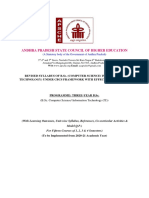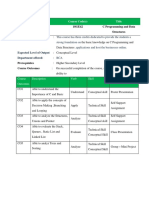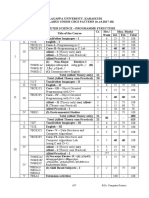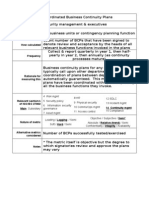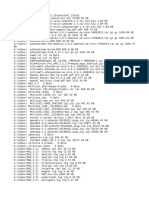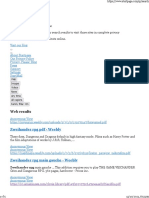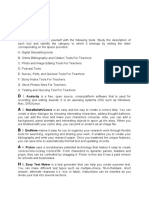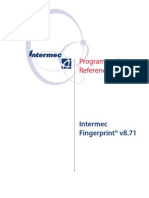Department of Computer Science and Engineering
NITK, Surathkal
Course Plan and Evaluation Scheme
(B. Tech 1st Semester, 2019-20)
1. Course Code: CS110
2. Course Title: Computer Programming
3. L-T-P: (3-1-0)
4. Credits: 04
5. Semester: B. Tech 1st Semester
6. Academic Year: 2019-20
7. Course Instructors:
S7: Annappa
S8: Vaishnavi T.
S9: Shashidhar G. Koolagudi
S10: Vani M.
S11: B. R. Chandavarkar
S12: Sharath Yaji
8. Teaching Department: Computer Science and Engineering
9. Objective of the course:
The aim of this course is to impart knowledge to analyze, solve, design and code
Real-life problems using the C language by
● Learning the basic concepts of computing and problem solving methodologies.
● Analyzing and applying the concepts of programming using ‘C’ language.
10. Skills to be developed:
● Solving problems
● Programming Aspects
● C Programming
● Structured/ Procedural Programming
Page 1 of 4
�11. Course Coverage (Table 1):
Sl. No. Duration
Topic Content
(A) (hrs.)
Types of programming languages,
Introduction to C
Features of C, Structure of a C program,
1 Programming 1
executing a C program, Characteristics
language
and applications.
Constants, Variables, identifiers,
2 C fundamentals keywords and Data types, Storage 2
classes.
C input/output Unformatted and formatted Input Output
3 2
functions functions.
Arithmetic, Relational, Logical,
assignment, conditional, increment or
Operators and
4 decrement, bitwise, special operators, 2
expressions in C
associativity and precedence of
operators.
Characteristics block diagram, parts of
Introduction to the computer and different kinds of
5 2
computer memory, hardware and software,
algorithm and flowchart.
Decision making and Different forms of if statements, switch
6 5
branching case, continue, goto, break.
Decision making and for, while, do-while, nested loop, jumps in
7 5
looping loops.
8 Arrays Single and Multi-dimensional array. 5
9 Strings String handling functions and operations. 3
Page 2 of 4
� Categories, arrays within functions,
10 Functions in C nesting of functions, Recursion, 5
Parameter passing methods.
Introduction, structure and array,
Structures and
11 structure and function, nesting of 4
Unions
structures, Bitfields and Unions.
12 Pointers in C Introduction, operations. 3
File management in Types of files, file modes and file
13 3
C functions, command line arguments.
Introduction, Object oriented
Object oriented
14 features,Comparison of Object Oriented 3
programming
Language with C.
15 Cyber security Introduction 1
Total No. of Hrs. 46
12. Reference Books:
[1] Balagurusamy, “C Programming” 3rd edition
[2] Yashwanth Kanetker, “Let Us C”
[3] Byron S Gottfried “Programming with C”
[4] Brian Kernighan and Dennis Ritchie “The C Programming Language”
[5] Balagurusamy, “Object oriented programming using C++”
[6] Herbert Schildt, “C: The Complete Reference”
Page 3 of 4
�13. Evaluation Plan (Table 2):
Sl. No. Weightage
Items Remarks
(B) (%)
1 End-Sem Exam 40 -
2 Mid-Sem Exam 20 -
3 Class Test 30 Sum of two tests, each of 15% weightage
Instructor’s
4 10 Assignments, Quizzes, Mini-Project, etc.
Discretion
Note:
● Sl. No. B1-B3 (Table 2) are common for S7-S12 sections
● Grading are common for S7-S12 sections
● Syllabus:
○ Class Test-1: A1-A6
○ Mid-Sem: A1-A8
○ Class Test-2: A9-A11
○ End-Sem: A1-A15
● Tutorial: Discussing at-least two challenging problems
Course Instructors: HOD
S7: Annappa
S8: Vaishnavi T.
S9: Shashidhar G. Koolagudi
S10: Vani M.
S11: B. R. Chandavarkar
S12: Sharath Yaji
Page 4 of 4
